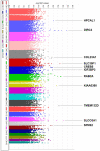Genome-wide association study of the response of patients with diabetic macular edema to intravitreal Anti-VEGF injection
- PMID: 36581632
- PMCID: PMC9800359
- DOI: 10.1038/s41598-022-26048-7
Genome-wide association study of the response of patients with diabetic macular edema to intravitreal Anti-VEGF injection
Abstract
Diabetic macular edema (DME), a complication of diabetes mellitus, is a leading cause of adult-onset blindness worldwide. Recently, intravitreal anti-VEGF injection has been used as a first-line treatment. This study analyzed the association between the genetic profile of patients with DME and their response to treatment. Intravitreal anti-VEGF injections were administered monthly for three months to Korean patients diagnosed with DME, who were classified into two groups depending on whether they responded to anti-VEGF therapy or showed recurrence within six months. Peripheral blood samples were used for genetic analyses. Genome-wide association analysis results sowed that the genes DIRC3 on chromosome 2 (rs16857280, p = 1.2 × 10-6), SLCO3A1 on chromosome 15 (rs12899055, p = 2.5 × 10-6), and RAB2A on chromosome 8 (rs2272620, p = 4.6 × 10-6) were associated with treatment response to intravitreal anti-VEGF injection. SLC35F1, TMEM132D, KIAA0368, HPCAL1, IGF2BP3, SPN2S, COL23A1, and CREB5 were also related to treatment response (p < 5.0 × 10-5). Using the KEGG pathway analysis, RAB2A and CREB5 were found to be associated with AMPK signaling related to VEGF (p = 0.018). The identified genetic biomarkers can elucidate the factors affecting patient response to intravitreal anti-VEGF injection and help select appropriate therapeutic strategy.
© 2022. The Author(s).
Conflict of interest statement
The authors declare no competing interests.
Figures




Similar articles
-
Identifying Genetic Biomarkers Predicting Response to Anti-Vascular Endothelial Growth Factor Injections in Diabetic Macular Edema.Int J Mol Sci. 2022 Apr 6;23(7):4042. doi: 10.3390/ijms23074042. Int J Mol Sci. 2022. PMID: 35409401 Free PMC article.
-
Biomarkers determining treatment interval of diabetic macular edema after initial resolution by anti-vascular endothelial growth factor.Graefes Arch Clin Exp Ophthalmol. 2024 Feb;262(2):421-429. doi: 10.1007/s00417-023-06269-w. Epub 2023 Oct 16. Graefes Arch Clin Exp Ophthalmol. 2024. PMID: 37843565
-
VEGF-A gene polymorphisms and responses to intravitreal ranibizumab treatment in patients with diabetic macular edema.Int Ophthalmol. 2018 Dec;38(6):2381-2388. doi: 10.1007/s10792-017-0738-5. Epub 2017 Oct 13. Int Ophthalmol. 2018. PMID: 29030794
-
Review on Recent Trials Evaluating the Effect of Intravitreal Injections of Anti-VEGF Agents on the Macular Perfusion of Diabetic Patients with Diabetic Macular Edema.Rev Recent Clin Trials. 2020;15(3):188-198. doi: 10.2174/1574887115666200519073704. Rev Recent Clin Trials. 2020. PMID: 32427087 Free PMC article.
-
Impact of Intravitreal Ranibizumab Therapy on Vision Outcomes in Diabetic Macular Edema Patients: A Meta-Analysis.Ophthalmologica. 2020;243(4):243-254. doi: 10.1159/000505070. Epub 2019 Nov 28. Ophthalmologica. 2020. PMID: 31775144
Cited by
-
The angiogenic role of the alpha 9-nicotinic acetylcholine receptor in triple-negative breast cancers.Angiogenesis. 2024 Nov;27(4):827-843. doi: 10.1007/s10456-024-09944-6. Epub 2024 Aug 23. Angiogenesis. 2024. PMID: 39177676
-
Dysregulation of CREB5 Impairs Decidualization and Maternal-Fetal Interactions by Inhibiting Autophagy in Recurrent Spontaneous Abortion.Reprod Sci. 2024 Jul;31(7):1983-2000. doi: 10.1007/s43032-024-01474-2. Epub 2024 Feb 29. Reprod Sci. 2024. PMID: 38424407
-
Several Common Genetic Variations Associate With Functional or Anatomic Effects of Anti-VEGF Treatment in Conditions With Macular Edema.Invest Ophthalmol Vis Sci. 2025 Jun 2;66(6):2. doi: 10.1167/iovs.66.6.2. Invest Ophthalmol Vis Sci. 2025. PMID: 40455044 Free PMC article.
-
Evaluating anti-VEGF responses in diabetic macular edema: A systematic review with AI-powered treatment insights.Indian J Ophthalmol. 2025 Jun 1;73(6):797-806. doi: 10.4103/IJO.IJO_1810_24. Epub 2025 May 28. Indian J Ophthalmol. 2025. PMID: 40434455 Free PMC article.
References
Publication types
MeSH terms
Substances
LinkOut - more resources
Full Text Sources
Medical
Miscellaneous

